| Article ID | Journal | Published Year | Pages | File Type |
|---|---|---|---|---|
| 6272991 | Neuroscience | 2015 | 11 Pages |
â¢Immunohistochemistry and cell density analysis of ischemic injury in cerebellum.â¢Purkinje cell death rapid and not via apoptosis following CA/CPR.â¢GluN2B antagonist selectively protects CA1 neurons.
Motor deficits are present in cardiac arrest survivors and injury to cerebellar Purkinje cells (PCs) likely contribute to impairments in motor coordination and post-hypoxic myoclonus. N-Methyl-d-aspartic acid (NMDA) receptor-mediated excitotoxicity is a well-established mechanism of cell death in several brain regions, but the role of NMDA receptors in PC injury remains understudied. Emerging data in cortical and hippocampal neurons indicate that the GluN2A-containing NMDA receptors signal to improve cell survival and GluN2B-containing receptors contribute to neuronal injury. This study compared neuronal injury in the hippocampal CA1 region to that in PCs and investigated the role of NMDA receptors in PC injury in our mouse model of cardiac arrest and cardiopulmonary resuscitation (CA/CPR). Analysis of cell density demonstrated a 24% loss of PCs within 24Â h after 8Â min CA/CPR and injury stabilized to 33% by 7Â days. The subunit promiscuous NMDA receptor antagonist MK-801 protected both CA1 neurons and PCs from ischemic injury following CA/CPR, demonstrating a role for NMDA receptor activation in injury to both brain regions. In contrast, the GluN2B antagonist, Co 101244, had no effect on PC loss while protecting against injury in the CA1 region. These data indicate that ischemic injury to cerebellar PCs progresses via different cell death mechanisms compared to hippocampal CA1 neurons.
